Genre: Shmup Developer: Sega of Japan Publisher: Sega of America Players: 1 Released: 1988
Back in the mid-1980s, horizontal shmups were still in their infancy. The games were pretty simple, with gameplay that by today’s standards, would seem archaic in ways to some. But of the shmups that came about during the ’80s, R-Type from 1987 became notable for its tough gameplay, its graphics and giant battleship, and the orb that you could attach to your ship. Oddly enough, this popular game never saw a release on the NES, despite how IREM was a third party for Nintendo’s system. Instead, the game was ported in 1988 to the only real competition the NES had; the SEGA Master System. But did this ship pull into port and dock successfully, or did it slam into the docking gates in a failed attempt? Read on.
From star system to star system they’ve moved; spreading terror, fear and death to all they’ve encountered. The Bydo Empire is a vicious foe that many others have had to face, but now, it’s the people of Earth’s turn. With the fate of mankind on the line, the Earth Defense League has turned to you to pilot the secret ship known as the R-9 in an attempt to stop the Bydo Empire and save this world from being their next victim. Are you up to the task?
The first thing you’ll notice about R-Type on the Master System, is just how nice looking the game is. Everything’s been shrunk down so that the Master System could handle the sprites better, but the details from the arcade game still show through. Yes, there’s color loss due to the MS’ reduced color palette and lower on-screen color count, but the graphics still put on a rather good show on the 8-bit system. While the shading on the ships, turrets, enemy organisms and such has been simplified, it’s still present and giving everything a sense of being three dimensional. The animation’s retained a good number of the frames from the arcade game, there are still plenty of details in the sprites and bosses, and the bosses are rather large as they move about the screen. Factor in a nice assortment of enemy types (robotic and organic), with bosses that each have distinctly different ways in which they attack you, and the game offers up some solid variety as you go from stage to stage.
The backgrounds are likewise toned down a bit, with no parallax present outside of the very opening space section. Despite this loss, they too got the same level of attention as the ported sprites. The organic and metallic nature of the stages still shines through, and the level of detail at times looks almost as good as some early 16-bit games on the Genesis. So, despite the trimmings and color loss that this port had to endure, the graphics are well done and make good use of the Master System’s color palette to create a respectable version of the arcade game’s visuals.
The sound in R-Type, while not fairing quite as well as the graphics in the porting process, still does a solid job. The U.S. music is done in PSG format, and isn’t as rich sounding as its arcade source due to fewer instrument types being used, and fewer instruments in general at times thanks to the system’s four-channel sound. Even so, each song is instantly recognizable and stays true to its origins, even if an instrument or two had to be removed. The songs themselves feature memorable melodies with varying tempos and moods being used that, at times, really fit with the stages the songs are featured with. Some are foreboding, others are bouncy or menacing, but as a whole, the soundtrack made the trip to the 8-bit system in fairly good shape.
However, there’s more than meets the ear with R-Type. In Japan, the music can be played through the Japanese version of the Master System’s FM module that features a YM2413 chip, giving the music more channels to use, and an entirely different feel. It’s the same soundtrack, but with a wider range of instruments being played that comes closer to mimicking the arcade music than the standard PSG music. It’s also fuller sounding, making for a more enjoyable listening experience that could almost pass for a Genesis soundtrack in quality.
The sound effects are pretty straightforward, and basically what you’d expect with a game like this. Shots get fired, various explosions go off and do their job depicting the death of something on-screen… things of that nature. Don’t expect realistic explosions and the like with this game, as even the arcade game didn’t feature them. That said, with the Master System’s PSG being used, some of the effects are tinny or irritating at times (like the Reflecting Laser). But aside from those instances, they do a fairly good job and don’t becoming grating. With the FM module though, they’re a bit better, featuring a broader range of sound types being used for shots, explosions, and whatnot. So, while the effects won’t be as well regarded as the music, they’re still doing a competent job with what’s needed for the battles happening on-screen.
When it comes to gameplay, R-Type was in a class of its own at release in the arcades, and the Master System version did well in capturing what the arcade game did. This game practically invented the idea of a “memorizer shmup,” where you more or less had to learn the correct way to get through the level. Randomness wasn’t in the cards with R-Type, which meant to be successful, you had to learn where to be at what point, what weapon to use against this or that section and boss, where the enemies came on-screen, and things of that nature. The game had a specific design, and you needed to learn that design to beat it. And the game gives you plenty to learn with eight regular stages that range from empty space, to bio-mechanical landscapes, bases, and more, filled with all manner of obstacles and aliens to shot and avoid. With this version of R-Type though, you also get a secret ninth stage not featured in the arcade game, complete with its own boss.
To face everything being thrown at you, the R-9 has myriad of weapons at its disposal. First, there’s a charge shot that can be used to inflict more damage by holding down button one for a couple of seconds. This has the side effect of leaving you more open to being killed since you’re not firing, but that’s the trade off in its use. You also get what’s called a Force; a large ball-like object that fires which you can attach to the front and back of your ship or launch it and allow it to float freely about until you call it to you by pressing button two. This Force can be powered up as well via three different kinds of lasers that you get by shooting certain enemies, with each laser have two power levels. The lasers are the Reflecting Laser (blue power-up), which shoots a three-beam spread that bounces off indestructible objects, the Anti-Air Laser (red power-up), which is a ring-like laser that blasts straight-forward only, and the Anti-Ground Laser (yellow power-up), which fires straight up and down simultaneously and then snakes along the ground/ceiling. Add in speed power-ups, a pair of Bit Units that you can pick up which shoot (if you have the Anti-Air Laser) and block small shots, how the Force can fire in two or four directions when it’s detached (depending on its power level), and a set of twin homing missiles that fire out of the front of your ship, and the game’s given you all you’ll need to face the Bydo hordes.
So it sounds pretty damn nice, right? But what’s wrong with this game? Well, sadly, there are some issues. R-Type really pushes the Master System hard, and it shows in the amount of slowdown that creeps in at times. As an example, on stage two, when you’re fighting the snake-like creature during the second half of the level, the game slows a fair bit the entire time it’s around. But the main issue with the game is that it flickers quite a bit, showing that the Master System wasn’t made to push the number of sprites R-Type demands. It rears its ugly head on nearly every level and can be pretty bad at times. And this problem leads to a final main issue. It can be tough to see what’s going on at times. With the smaller sprites (and thus smaller missiles/shots), and the simplified color palette/recoloring in the backgrounds, enemy ships and bullets can get hidden among the details. Couple that with the flicker, and you can find yourself not only dying in places, but not seeing yourself die.
On the lesser side of things, some backgrounds feature an odd issue where you can see the graphic tiles end in a section of solid color just before those backgrounds get close to what would have been a closer layer of parallax. Not all of the backgrounds do this, but some do, which seems like a rather strange issue to leave behind since everything’s been flattened into one layer. Other minor graphical issues include how there are missing bits of graphics (like the other types of explosions), that the backgrounds fade to black at bosses (a Master System staple), how the strip with the score and laser charge level bar is missing, and that there are changed colors over the arcade game (like stage two’s blue background on the SMS vs. the gray one in the arcade, among many examples). The list of minor gripes continues with the audio, and how the PSG music can produce some rather piercing notes in some of the songs, and how instruments get dropped in the PSG songs when sound effects play (sometimes there are only two instruments going as a result). Also, fighting the bosses also seems easier when compared to the arcade game. But, it might just have been me. Either way, all of these nitpicky things add up to enough to take away from the overall presentation, which hurts the game a little.
In the end, what we have with R-Type on the ol’ Master System is a game that SEGA obviously didn’t want to cut too many corners on. This game was basically an exclusive for the system, after all. But in not reducing the sprite count and size more than it already did, it was left with the technical limitations of the system being up on the screen more than anyone would have liked. So while we got a faithful port of the arcade classic that showed what the Master System could do in terms of graphics, the game tends to do a fair bit of chugging and blinking as it goes along with its visual show. But if you can overlook that and the tinniness of some of the PSG music, you’ll find a good and fun 8-bit port of a classic shmup that nails the gameplay with solid visuals and fairly good music… along with a little extra love hidden in it.
SCORE: 8 out of 10

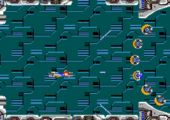
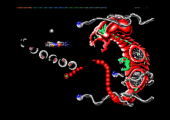
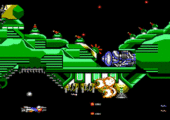
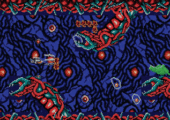
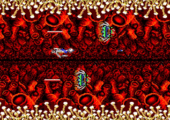
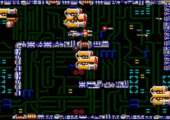
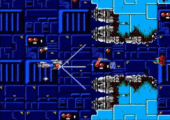
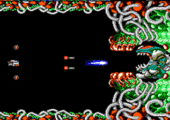
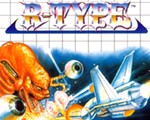
I would say that this was the game that made me happy of buying a Master System. It was very impressive at the time and still shows how much the console could do with proper work and some dedication. What a great game.